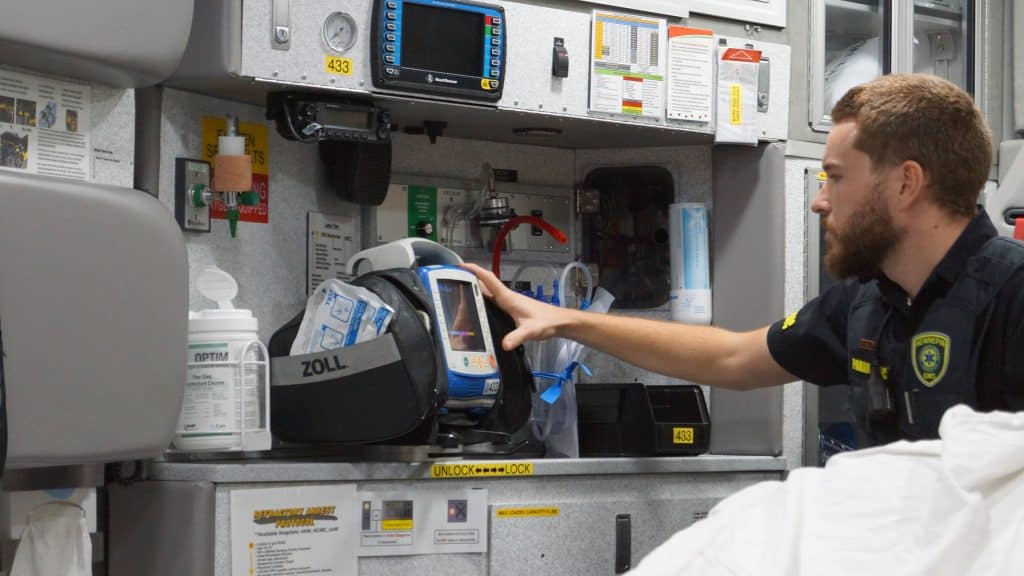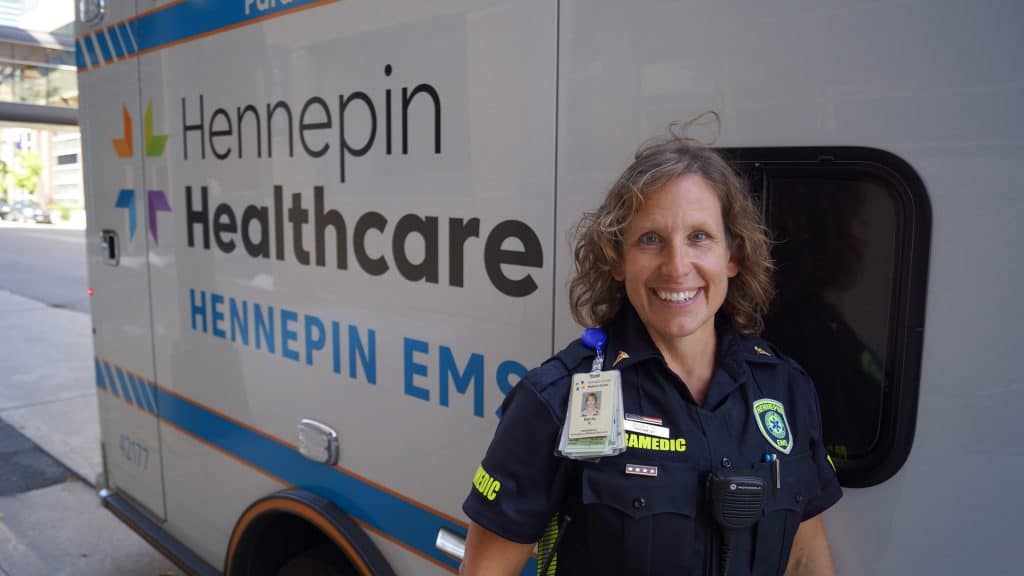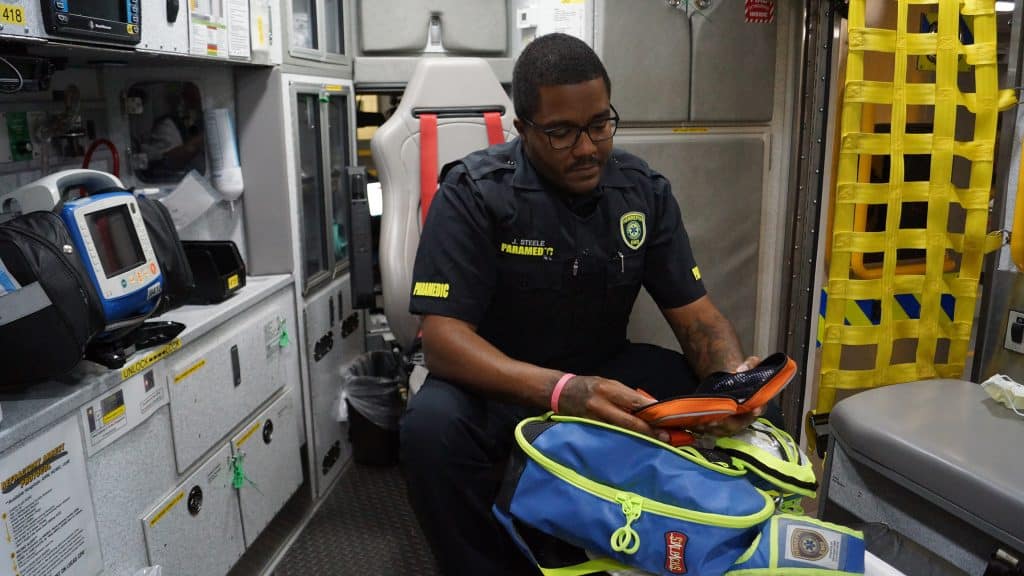Calm in the Storm: How Hennepin EMS is Reaching
Into the Community, One Patient at a Time
Riding in an ambulance with paramedic Xander Krohnfeldt, it seems the more agitated his patient gets, the more calm his voice becomes. Krohnfeldt works for Hennepin Emergency Medical Services (EMS), where he provides front line care to people throughout their primary service area in Hennepin County.
Last year Hennepin EMS made more than 80,000 ambulance runs, responding to a wide variety of emergencies. In this case, Krohnfeldt’s patient just woke up from a seizure and she is frightened and disoriented.
Krohnfeldt carefully explains where she is: “You’re in an ambulance. We’re taking you to the hospital.”
What happened: “You had a seizure and you were unconscious for a while.”
And why she is feeling so uncomfortable: “Your body just went through something really difficult… like it ran an entire marathon. I know it’s difficult right now but I want you to just focus on your breathing.”

By the time the ambulance reaches the Hennepin Healthcare Emergency Department at HCMC, the woman is more relaxed. She’s alert and answering questions. Through it all, Krohnfeldt’s demeanor never changes.
“A huge portion of the job is being able to talk to people. You're walking through a crisis with an individual and that varies dramatically from person to person,” said Krohnfeldt. “You walk into very chaotic situations. You need to stabilize those situations and not add to the chaos. A lot of that comes down to the tone.”
Krohnfeldt is one of a team of more than 160 paramedics at Hennepin EMS. Twenty-four hours a day, seven days a week, they attend to people from across the community dealing with situations and conditions that can be overwhelming. Car accidents, shootings, overdoses, heart attacks, mental health issues… each EMS shift reads like a laundry list of health maladies and societal ills.
In addition to paramedic services, Hennepin EMS also offers Emergency and Critical Care education to train and certify healthcare professionals on life support techniques. Hennepin EMS Emergency Medical dispatchers coordinate responses, provide pre-arrival medical instruction and manage the West Medical Resource Control Center (WMRCC). Hennepin EMS Special Operations division provides medical coverage at large events and sports venues. Together, the Hennepin EMS team tackles whatever comes their way with one goal in mind: making things better.
“We’re there to help,” said Martin Scheerer, Senior Director of EMS at Hennepin Healthcare. “I feel good that we approach each case with compassion and we’re able to help people during their worst days and times.”
RAPID RESPONSE AND CALMING PRESENCE
Paramedics typically work eight to 14 hour shifts, arriving at the station ready for anything. A dashboard screen in the ambulance shows a rolling list of 911 calls that come in requiring EMS response. There are around 40 “codes” used to signify a wide range of emergencies. One call could be for someone who is confused about a medication they are taking. The next could send paramedics to a mass casualty accident or shooting.
“We are here for their emergency. Whoever has called us, whether that's the patient, a family member, or a bystander, we're here for somebody's emergency,” said paramedic Becky Kopka. “I don’t make judgments. I understand that I’m there to help them.”
Despite what you see in movies and on television, paramedics rarely run. It’s not that they aren’t in a hurry to help. It’s because they know when they arrive on a scene, they need to be ready to do their job.

“Typically, our pace is not an indicator of our feelings about whatever we're walking into,” said Krohnfeldt. “The fact is when you arrive, if you sprint you're not going to be in a place where you can calmly assess a situation, deescalate the stress or tension of a scene, and provide the right kind of care.”
“I think there are some people that think we're going to come screaming up and we're not even going to get that truck into park before we’re bailing out and running with our equipment,” added Kopka. “If you walk into a scene hyped up, people are going to feed off of that. If we remain calm even on those scenes that are the most intense, things work out better.”
Due to the nature of the calls they receive, paramedics often find themselves in dangerous situations, so they need to be on high alert. Even a seemingly simple situation can become complicated in a hurry.
“Just because you’re there to help, doesn’t mean that you are always welcome,” said Kopka. “I’m approaching someone on their worst day and I need them to understand I’m there to do whatever I can to make it better.”
“As you're getting out of your rig and going up to the apartment, the house, or the side of the road, you try not to get blinders on,” said paramedic Jeremiah Steele . “You can feel the energy of groups and crowds of people as you approach. Sometimes it's curiosity or concern. Sometimes you can feel a little bit of hostility at a scene.”
HEIGHTENED TENSIONS AND NEW CHALLENGES
Unfortunately, the hostility and threats have become more prevalent in the past couple of years. Scheerer says a combination of COVID-19, political unrest in the wake of the murder of George Floyd, and some shifting perceptions about first responders have combined to make the job of a paramedic even more dangerous than before. Often that has meant more police on the scene with the EMS workers, which can then add to the tension.
“I've been assaulted. I've been kicked, punched, shot at,” said Krohnfeldt. “A lot of times, unfortunately, when we show up in an ambulance and we say, ‘We're here to help,’ it seems like there are still people wanting to do us harm.”
Scheerer says he understands the fear, distrust and anxiety that many people are feeling right now. He is proud of the way the EMS team operates and he is committed to continuing to connect and earn the trust of every member of the community.
“Let's look at ways to improve an already high performance organization, one that our employees are proud to be a part of and that the community is proud of,” said Scheerer. “Continuous improvement doesn’t mean something is broken, it means always improving things like our response time and our clinical standards and resuscitation efforts. It's a very, very big recipe with a lot of ingredients. We’re always looking at each ingredient and asking how we can do a little better. We also want to increase the diversity of our team.”
INCREASING DIVERSITY AND SUPPORTING STAFF
As with other health care professions, there is a national shortage of paramedics right now. Staffing issues have forced Hennepin Healthcare EMS professionals to work even longer hours than normal, postponing needed breaks and vacations. In an effort to help address this issue, Hennepin Healthcare created a program to help Emergency Medical Technicians (EMTs), who have a lower level of training, get on a track to become full paramedics. The cost of the training, which can be a barrier for many, is waived if the participant works for two years as a Hennepin paramedic.
“There are thousands of EMTs looking for work so we have started hiring them and training them to become paramedics,” said Scheerer. “We’ve recruited talented people who have great customer service skills, who are interested in serving the community. It’s also helped us increase the diversity of our hiring pool.”
The first week of announcing the new program, Scheerer said they had 257 people apply for 24 positions. Building on that success, they are now marketing the program to underrepresented communities to try to develop a paramedic force that more closely reflects the population Hennepin Healthcare serves.
Paramedic certification normally requires two years of medical training, but for Hennepin Healthcare EMS that’s just the beginning. Scheerer says paramedics need to learn the softer skills of the job such as how to talk with patients and families, how to maintain empathy and understanding, and how to de-escalate tensions when necessary. To accomplish this, Hennepin has new hires ride along with experienced staff, first as a third team member, then as a second team member, to learn from their colleagues.
Steele recently completed his paramedic education. He says the on-the-job training made a huge difference.
“We are there to help, first and foremost. We're not there to prosecute you or persecute you,” he said. “I want people to understand that we're always there to lend a helping hand. To see us there as someone who can help and to understand we're there for the best interest of you or your family members or friends.”

Another way Hennepin EMS is trying to improve is by supporting the mental health of staff. The stress and emotion of the job can build up quickly. Scheerer says paramedics need an outlet to process everything they witness day after day.
“Some things will always stick in your mind that are tough to get rid of so we provide mental health support,” said Scheerer. “We’re understanding the importance of resilience training, coping skills. We’re trying to make it OK to talk about mental health issues. In the past it’s been something where people just said suck it up, that’s the way it is. Now we’re getting people to say it’s OK to talk about it.”
“If you work this job, you're going to see the effects of alcohol dependency, drug use, homelessness, domestic abuse. There are things that you can count on seeing almost every single shift,” said Krohnfeldt. “There's an aspect of getting used to it, but you can’t let yourself become any less compassionate about those things. It just means that little by little you get the ability to be calm and help those situations instead of being emotionally affected every time.”
DRIVEN TO MAKE A DIFFERENCE
Being a paramedic requires a unique combination of having a short memory but a deep understanding. Given the relentless nature of every shift, the medics need to be able to quickly move past difficult, and sometimes heartbreaking, incidents so they can focus on what’s next. At the same time they need to allow every experience and every bit of training to inform their approach and their decisions in the future, so they can make a difference for whomever they are called to next.
“It's not just a person. This is somebody who means something to somebody and they have those connections. They have their friends, their family members,” said Kopka “I don’t do it to be recognized. I come out here and do this because I enjoy the medicine side of it and I also enjoy helping people. It's nice to get that person to a better place and just know that you've done something for them. And I think at the end of the day that's probably what brings me back day in and day out.”
Steele says his goal is to earn the community’s trust every day, so the residents see him and his colleagues as allies, not adversaries.
“If you do see us out in the community, come and talk to us. All of the medics who work here, the chiefs, they're all friendly,” said Steele. “If you ever have that hesitation in your head, come and talk to us. We're not some authoritarian figure that you should be afraid of. I think if the community speaks to us, and they realize we're just regular people like them, they won't hesitate to call us when they truly need us.”
The paramedics understand and appreciate the role that they play in the community and at the same time they realize they can’t take any day for granted. Few jobs provide the chance to actually save lives, so they are committed to bringing their best selves on that journey every day.
Reprinted from the Mill City Times.

